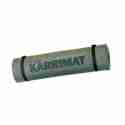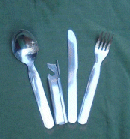Practical Airsoft Recommends:

Basic (DVD)

Basic (VHS/PAL UK Video)

Fuji Finepix A204 digital camera

Cobra Microtalk 110 PMR446 2-way radio
"No Coffee?! |
Useful kit for the field...
- So what should you get?
- So. What should you get first?
- Torches
- Sleeping kit...
- Tents.
- Sleeping Bags...
- Kip (or 'roll') mats
- OK, feeding yourself...
- Field Cookers
- Utensils (Pots, pans, and eating irons!)
- Thermos flasks...
- A final-note...
By and large, in the Army, a soldier, after a while, begins to figure out just what he (or she!) should purchase, to make life in the field that much more comfortable. Why, therefore, should you be any different? You're no soldier, you're a civilian, out to enjoy a good days' gaming - and it is, after all, your money!
So what should you get?
Firstly, lets not forget that most times, you will not need overnight equipment, just gear to keep you happy during the course of a one-day gaming event. However, there will be times where Airsoft Skirmish sites will advertise a full weekends' gaming. For these, you will need overnight kit. Unlike a soldier, though, you don't need to worry that much about the weight of your overnight gear, as you won't be humping it on your back all over the countryside, so costs should come down (the lighter and better the gear, the more costly it will be!).
Well, with the above in mind, there's a few recommendations I'll make; nothing too silly, and nothing too expensive (long term expensive, that is), but all of which having the potential to increase your comfort, and thereby your enjoyment, when out Airsoft Skirmishing (especially in those cold wet winter months!).
So. What should you get first?
Actually, a bit more clothing. Specifically, a set of waterproofs, camouflaged to your preferred pattern and style. These can get a little pricey, but if you follow my advice about clothing, you shouldn't go too far wrong.
Torches
Next, you'll need a torch. There are three I'll recommend, all of which being readily available from most good outdoors and army surplus shops. Letters after the description relate to the batteries used by that model of torch (for the benefit of our US visitors, a torch is a "flashlight"!)
- Mini Maglite (AA)
- Mity Lite (AAA)
- Lucido Lightwave (AA)
Sleeping kit...
Sleeping kit covers three main things: Overhead cover, warmth, and comfort. These can be translated to tents, bags, and kip (or 'roll') mats.
Tents.
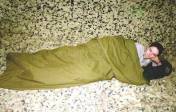
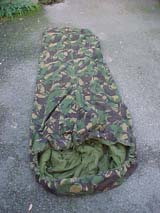 Unless you intend to have a few freinds in your tent, you can either make do with a poncho-like cover, or buy a purpose-made 'bivvy bag', which is a self-contained one-person tunnel tent. Most of these do not need rigging of any kind, you just unroll them, get in, zip up, and that's that. However, it is, as you'd expect, a little more complex when selecting one.
Unless you intend to have a few freinds in your tent, you can either make do with a poncho-like cover, or buy a purpose-made 'bivvy bag', which is a self-contained one-person tunnel tent. Most of these do not need rigging of any kind, you just unroll them, get in, zip up, and that's that. However, it is, as you'd expect, a little more complex when selecting one.
 My nine-year old faithful companion is still going strong, and is a hooped bivvy bag, with a Goretex lining and zipped anti-mosquito net built-in. No leaks, rips, or problems in nine years, there, but I did intend it to be top quality, and paid a princely sum for it. I wouldn't be surprised to find a similar example fetches around two hundred and fifty quid, these days. You, however, are likely to be on a much reduced budget.
My nine-year old faithful companion is still going strong, and is a hooped bivvy bag, with a Goretex lining and zipped anti-mosquito net built-in. No leaks, rips, or problems in nine years, there, but I did intend it to be top quality, and paid a princely sum for it. I wouldn't be surprised to find a similar example fetches around two hundred and fifty quid, these days. You, however, are likely to be on a much reduced budget.
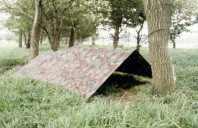 I'm therefore going to suggest to low-tech alternative: An "SASS Aussie Hootchie Basha", which is available from SASS. Measuring roughly 1.7 by 2.85 metres, of reasonably waterproof Taslan, and fitted with 'D' rings, to make it easier to erect (tie to trees, or whatnot), it's able to be used as a rough dome tent, to sleep two, or, using the press-studs it comes with, can be used as a one-man tunnel tent, with a built-in ground sheet (to keep you dry). It does, however, cost about twice the price of a normal basha roll, at (in November 2000) £64.50, excluding delivery costs. For reference, the PLCE Basha (not nearly as good quality, surprisingly enough) is £65 from Silvermans's (again, excl. delivery, November 2000).
I'm therefore going to suggest to low-tech alternative: An "SASS Aussie Hootchie Basha", which is available from SASS. Measuring roughly 1.7 by 2.85 metres, of reasonably waterproof Taslan, and fitted with 'D' rings, to make it easier to erect (tie to trees, or whatnot), it's able to be used as a rough dome tent, to sleep two, or, using the press-studs it comes with, can be used as a one-man tunnel tent, with a built-in ground sheet (to keep you dry). It does, however, cost about twice the price of a normal basha roll, at (in November 2000) £64.50, excluding delivery costs. For reference, the PLCE Basha (not nearly as good quality, surprisingly enough) is £65 from Silvermans's (again, excl. delivery, November 2000).
Sleeping Bags...
 Ok, unless you intend to be out in the snow and ice, you shouldn't need much more than a basic military style sleeping bag (I should mention that in the Army, you sleep with your clothes ON in the field, thus boosting the heat retention values of your sleeping bag); most outdoors and army surplus shops and catalogues have a reasonable range to choose from. I would recommend that you select a bag that's good from about 10 degrees Centigrade through to about minus five to ten Centigrade, which should cater for most weather conditions we encounter in the UK (a so-called two to three season bag). Even so, for a good quality bag, expect to pay from £40 for the grottiest level, to £150 for a good or bloody good, quality bag, to meet this specification.
Ok, unless you intend to be out in the snow and ice, you shouldn't need much more than a basic military style sleeping bag (I should mention that in the Army, you sleep with your clothes ON in the field, thus boosting the heat retention values of your sleeping bag); most outdoors and army surplus shops and catalogues have a reasonable range to choose from. I would recommend that you select a bag that's good from about 10 degrees Centigrade through to about minus five to ten Centigrade, which should cater for most weather conditions we encounter in the UK (a so-called two to three season bag). Even so, for a good quality bag, expect to pay from £40 for the grottiest level, to £150 for a good or bloody good, quality bag, to meet this specification.
The 58 pattern Sleeping bag, incidentally, covers this speciication quite well, and you can get hold of reasonable items at a fair price. Check, however, the ZIP, and the PU Waterproofing layer on the underside of the bag (replacement zips are getting difficult to source, and the waterproofing is expensive (if not virtually impossible) to replace properly), before you pay for a 58 pattern bag.
If you cannot get a 58 pattern bag, the PLCE bag is OK, if a little more expensive (and lacks the waterproofing layer on the underside, so get a tent or bivvy bag as well!), but generally of better quality that a 58 pattern bag.
Kip (or 'roll') mats
OK, feeding yourself...
Right; you've played, slept overnight, and now it's morning. Snag is, all the site provides is a burger-style lunch, and no hint of breakfast. Since breakfast is the single most important meal of the day, it stands to reason that you should possess the where-with-all to have it when you wake up in the field.
I do NOT recommend de-hydrated foods. While they're light in weight, they taste, in my opinion, bloody disgusting, and require a significant amount of water to re-constitute them, which can hurt you, if you only have a one-litre water bottle, and no re-supply of clean water available to you.
 |
 |
 Do not, however, think that this is it; if you need to build your own 'ration pack', it can be expensive. If you can, get to an army surplus shop that stocks UK Ration packs, or, at worst, United States MRE packs (Meal, Ready to Eat) (YUK! not as good as GP ration packs, and you need THREE MRE packs to one GP pack, for a full day's rations!). You could also use the German Military's answer to field rations, and EPA pack; these are good for 24 hours, and come in a brown cardboard box; while containing much more than a US MRE, they contain slightly less than a British GP pack (in terms of the drinks, etc), but are good to go; the only downside is that they are a tad difficult to fit into the issue British large mess tin, being sized to fit the German mess kit, instead.
Do not, however, think that this is it; if you need to build your own 'ration pack', it can be expensive. If you can, get to an army surplus shop that stocks UK Ration packs, or, at worst, United States MRE packs (Meal, Ready to Eat) (YUK! not as good as GP ration packs, and you need THREE MRE packs to one GP pack, for a full day's rations!). You could also use the German Military's answer to field rations, and EPA pack; these are good for 24 hours, and come in a brown cardboard box; while containing much more than a US MRE, they contain slightly less than a British GP pack (in terms of the drinks, etc), but are good to go; the only downside is that they are a tad difficult to fit into the issue British large mess tin, being sized to fit the German mess kit, instead.
By the way, if you're interested, I've actually gone out of my way to sample both British and German ration packs recently (damn, but am I a brave guinnea pig, or what? ![]() ), and here's a few notes about the GP and EPA rations for you. And no, I haven't tried the US MREs of late - I may be brave, but I'm definately not stupid
), and here's a few notes about the GP and EPA rations for you. And no, I haven't tried the US MREs of late - I may be brave, but I'm definately not stupid ![]() !
!
However, for more information regadring US MREs, you can do worse than visit http://www.mreinfo.com;/ He's been kind enough to mention this site in his article on GP rations (even if he did nick my bit concerning the sundries package), so I reckon it's fair enough to give him a plug as well ![]()
Failing this, you'll need two main meals, one of which should be a breakfast type, and a sweet for your evening meal. Invest in some confectionary (Mars, Yorkie, Snickers, whatever), some digestive biscuits, and whatever else you think you'll need over the course of a day's hard exercise while playing the game (don't forget your tea bags or sachets of coffee, plus sugar and powdered milk or non-dairy creamer packets!), and pack it carefully into a reasonably safe, small, box, or your utility pouches on your webbing. Next, you'll need a field cooker...
Field Cookers
A field cooker is designed to do one thing - heat up your food and/or water (usually both at the same time). There are currently four common types of commercial individual field cooker on the market; these are:
- Alcohol gel
 Alcohol Gel cookers come in a small tin, and don't last that long. Also, they get very hot when cooking, and can take a long time to cool down enough for you to be able to handle them after use. They also tend to get expensive if you use them a lot. The ONLY place I could find somewhere sellng these in February 2002, by the way, was Soldier of Fortune, in Wales.
Alcohol Gel cookers come in a small tin, and don't last that long. Also, they get very hot when cooking, and can take a long time to cool down enough for you to be able to handle them after use. They also tend to get expensive if you use them a lot. The ONLY place I could find somewhere sellng these in February 2002, by the way, was Soldier of Fortune, in Wales.
- Solid Fuel Block
 Solid Fuel Blocks are normally associated with folding metal stoves, which also happen to be the basic cooker of a British soldier in the field. Using a 'Hexamine' or solid paraffin fuel block, they also burn rather smokily, leaving a filthy black residue on the undersides of your cooking utensils. The smoke also tends to smell a little distinctive. The advantage of this type of cooker is that it's bare bones reliable, as long as you can actually get the solid fuel blocks to light (there's a trick to it, believe me), and that they're cheap and easy to get (virtually everywhere in the UK outdoors shopping market stocks them). The downside is the smell and filth they produce, as a by-product of the burning process.
Solid Fuel Blocks are normally associated with folding metal stoves, which also happen to be the basic cooker of a British soldier in the field. Using a 'Hexamine' or solid paraffin fuel block, they also burn rather smokily, leaving a filthy black residue on the undersides of your cooking utensils. The smoke also tends to smell a little distinctive. The advantage of this type of cooker is that it's bare bones reliable, as long as you can actually get the solid fuel blocks to light (there's a trick to it, believe me), and that they're cheap and easy to get (virtually everywhere in the UK outdoors shopping market stocks them). The downside is the smell and filth they produce, as a by-product of the burning process.
- Butane Gas
 Butane Gas, or more commonly called 'Camping Gaz' cookers are common, popular, and readily available. The snag is that in cold conditions, they can take ages to produce any meaningful heat, as their efficiency drops in the cold. Never the less, they're plentiful, reasonably priced, and simple to use. They also burn cleanly, and have no real odour when cooking.
Butane Gas, or more commonly called 'Camping Gaz' cookers are common, popular, and readily available. The snag is that in cold conditions, they can take ages to produce any meaningful heat, as their efficiency drops in the cold. Never the less, they're plentiful, reasonably priced, and simple to use. They also burn cleanly, and have no real odour when cooking.
- Liquid Fuel
 Liquid Fuel cookers are the best all round cooker you can buy, in my opinion, although they are expensive to purchase. I advise buying a 'multi-fuel' model, that's capable of using 'Coleman' fuel, as well as unleaded petrol or paraffin. They cook with a clean (unless you use paraffin) flame, are reliable when looked after, and cook quickly, as well. The down side is the fuel, which must be handled with care - it is, after all, a petroleum spirit, and extraordinarily flammable!
Liquid Fuel cookers are the best all round cooker you can buy, in my opinion, although they are expensive to purchase. I advise buying a 'multi-fuel' model, that's capable of using 'Coleman' fuel, as well as unleaded petrol or paraffin. They cook with a clean (unless you use paraffin) flame, are reliable when looked after, and cook quickly, as well. The down side is the fuel, which must be handled with care - it is, after all, a petroleum spirit, and extraordinarily flammable!
- Liquid Fuel - example two
Another good example of a liquid fuel stove is the MSR Whisperlite; this has been a faithful companion to me through seven and a half years in the T.A., a number of backpacking holidays, and scores of Airsoft events (We're talking something like eleven years, here!). It's NEVER let me down, and I whole-heartedly recommend it to you. It sits lower on the ground, and it thus more stable a mounting for your cooking pan that the Coleman, and uses the same fuels as the Coleman stove (above) but, as it collapses down into the stove and a separate fuel container, can be packed in a somewhat easier fashion. While it takes a little longer to get going (set-up time is a factor), it's still a good choice.- Zest-O-Therm MRE heater packs
 In addition to the forms of cooker noted above, there is one final, very specialised, 'cooker' (and I use that word loosly, as well). The Zest-O-Therm MRE heater. This is a chemical heater that comes with each pack of a modern United States MRE ration pack (and they're so sized as to be pretty-much useless for any other form of ration pack doing the rounds right now, so if you use MREs, get a few of these, otherwise, don't bother!). Since they require a small amount of water to work, they are probably the simplest to use, although be warned: Do NOT smoke when cooking with them - they give off hydrogen gas as a by-product of the cooking process - you could get a rather explosive shock if you're not careful!
In addition to the forms of cooker noted above, there is one final, very specialised, 'cooker' (and I use that word loosly, as well). The Zest-O-Therm MRE heater. This is a chemical heater that comes with each pack of a modern United States MRE ration pack (and they're so sized as to be pretty-much useless for any other form of ration pack doing the rounds right now, so if you use MREs, get a few of these, otherwise, don't bother!). Since they require a small amount of water to work, they are probably the simplest to use, although be warned: Do NOT smoke when cooking with them - they give off hydrogen gas as a by-product of the cooking process - you could get a rather explosive shock if you're not careful!
Utensils (Pots, pans, and eating irons!)
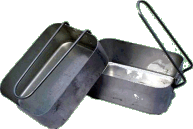 Right from the start, let's keep this simple. Get a pair of British Army mess tins - the proper ones, not the Chinese knock-offs. You can tell a genuine set by the military crows' foot ('arrow', to you!) on the outside hinge of both tins.
Right from the start, let's keep this simple. Get a pair of British Army mess tins - the proper ones, not the Chinese knock-offs. You can tell a genuine set by the military crows' foot ('arrow', to you!) on the outside hinge of both tins.
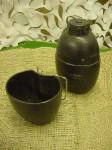 For drinking, get a genuine MoD water bottle and mug set. They work well, and are cheap, as well as being available almost everywhere in army surplus shops. Once again, ensure thet they're the genuine article, by looking for the military crows' foot markings on both the bottle and the mug.
For drinking, get a genuine MoD water bottle and mug set. They work well, and are cheap, as well as being available almost everywhere in army surplus shops. Once again, ensure thet they're the genuine article, by looking for the military crows' foot markings on both the bottle and the mug.
As to spice holder/dispensers, if you really need them (to carry salt and pepper around with your rations), then invest in a sealable camping cruet set. Get advice from the store staff on this, but don't settle for something cheap and nasty - it'll fail you just when you don't want it to!
Thermos flasks...
You want one that will stand up to a hell of a lot of abuse - I've LANDED on mine before now (believe me, it HURT ![]() ), and despite being rather dented (like, oval cross-section, man!) it's still working just fine, so get an 'unbreakable' one, made from either steel or aluminium. The 'Thermos' or 'Alladdin' brands are both good choices, by the way...!
), and despite being rather dented (like, oval cross-section, man!) it's still working just fine, so get an 'unbreakable' one, made from either steel or aluminium. The 'Thermos' or 'Alladdin' brands are both good choices, by the way...!
A final note...
There will be some playing sites that for one reason or another, don't have toilets - and let's be honest here, stuff the civilised norms of behaviour that say that potty breaks have to be in private, in a nice cozy water closet - when you gotta go, you gotta go!
Since we're always hearing about helping the environment, I suggest you carry some bio-degradable toilet paper, and some environmentally-freindly soap. If all else fails, you can always dry your hands on your coat, but it might be an idea to take a small towel with you too (just in case)!
This brings me to the final note in this section - washing kit. For those all-weekend games, a wash kit is a definate essential. The bare minimum is soap, flannel, tooth brush, tooth paste, and your choice, if a bloke, of either dry or wet shaving gear - and on this last item, remember: In the woods, there aren't any three-pin electric sockets, so take plenty of batteries if you use a battery-operated shaver!











